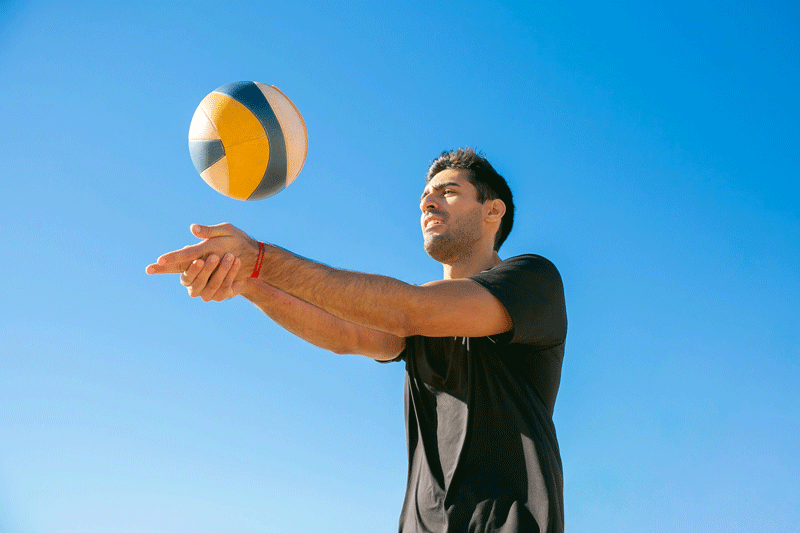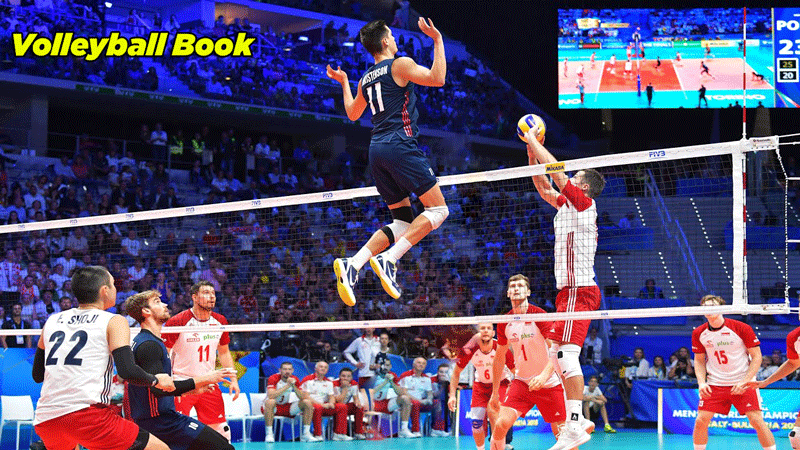How Long Are Volleyball Games:(School to Pro Levels)
One of the most common questions asked by spectators at volleyball games is about their duration. Unlike many other sports, volleyball isn’t bound by a strict time limit.
In theory, volleyball games can last for hours, though in practice they rarely do. However, the length of volleyball games can vary significantly depending on the level of play.
In middle school and junior volleyball games, matches are typically short and seldom exceed an hour. High school games, on the other hand, can extend up to two hours. As the level of competition increases to college and professional levels, volleyball games often last more than two hours.
How Long Are Volleyball Games? The duration of a volleyball game is primarily determined by the number of sets played. However, other factors also contribute to the overall length, such as breaks, point caps, and the intensity of competition.
In this article, we’ll delve into these factors in detail to provide a comprehensive understanding of the length of volleyball games at different levels. By the end, you’ll have a clear grasp of what influences the duration of volleyball matches.
Exploring Different Levels of Volleyball
One of the key distinctions between different levels of volleyball lies in their set systems. Many people inquire about the number of periods in volleyball, but they’re actually referring to sets – which serve as the game periods in volleyball.
So, how many sets are played in a volleyball game? There are two primary point systems utilized worldwide: the 3 out of 5 system and the 2 out of 3 system. Now, for newcomers, this might sound confusing, so let’s break it down further.
Volleyball doesn’t have a time limit. It’s highly unlikely for a referee to end a game due to its duration – in volleyball, there’s no such thing as a game being too long. Instead, volleyball has a set limit, similar to tennis.
At certain levels of play, such as middle school and amateur games, the 3-set system is employed. Here, teams compete in three sets, and the team that wins two out of those three sets emerges victorious.
But is it always three sets in volleyball? Not necessarily!
Higher levels, such as high school, college, and professional leagues, often adopt the 5-set system. In these matches, teams can play up to five sets, and the team that wins three sets takes the victory.
A clear pattern emerges here – regardless of the system, a team must win the majority of sets (2 out of 3 or 3 out of 5) to secure the win. Naturally, if a team clinches three consecutive sets, they won’t continue playing additional sets since they’ve already won the majority required. Similarly, in the three-set system, if a team secures two consecutive sets, the game concludes.
Thus, the pivotal factor in determining the length of a volleyball game is the number of sets played. Notably, 5-set games tend to last longer than 3-set games.
To win a set in volleyball, teams must accumulate 25 points with a 2-point difference, meaning the minimum winning score is 25-23. However, as the level of competition rises, securing points becomes more challenging, prolonging the duration of rallies.
This aspect will be discussed further in the chapter titled ‘How Long Is a Rally?’
Now, let’s address the most pressing questions: How long are high school volleyball games, and college volleyball games, and what is the average volleyball game time?
Middle school games typically last no more than an hour, barring any disruptions to game flow. In contrast, high school games can extend up to two hours, with rare instances lasting even longer.
College matches often surpass the two-hour mark. College teams are typically evenly matched, benefiting from significant investments in training facilities, staff, and player scholarships. Consequently, rallies can be prolonged, leading to game durations ranging from an hour and thirty minutes to nearly three hours.
Professional volleyball games generally last around two hours. Similar to college matches, these games may also exceed the two-hour mark due to the intense competition and prolonged rallies. Professional players exhibit a remarkable devotion to the sport, tirelessly fighting for every point, which can extend rallies, sets, and overall game time.
Despite the longer durations, watching professional volleyball is truly captivating, showcasing the athletes’ dedication and skill.
Factors Affecting Volleyball Game Length

Determining the typical duration of volleyball games is complex and involves various factors beyond just the number of sets played.
Firstly, the disparity in quality between teams significantly affects game duration. When one team vastly outmatches the other, the game may end swiftly with the dominant team securing victory in two or three consecutive sets. Such quick games are more common in amateur leagues where skill levels vary widely.
As the level of competition increases, teams become more evenly matched, leading to longer and more intense matches. It’s rare for a college team, for example, to defeat another college team 3-0, as this would signify a significant mismatch.
Unlike sports like soccer, volleyball doesn’t allow for defensive strategies to simply maintain a scoreline. With only three touches allowed, the game revolves around swiftly transitioning from defense to offense. Consequently, aggressive teams tend to fare better, often concluding games more efficiently.
Another factor impacting game duration is rule variations, particularly regarding timeouts. Different levels of play have varying timeout rules, with teams typically allotted one or two timeouts per set, each lasting between one and three minutes. Increased timeout usage can prolong game time, while minimal usage shortens it.
Timeouts are more prevalent in professional and college volleyball compared to middle school games. Younger players may struggle to follow instructions or maintain focus when losing, leading coaches to refrain from using timeouts altogether.
Additionally, changes in player substitutions are more common at higher levels, where roles are more specialized. In contrast, lower-level volleyball tends to have clearer and more specific player roles, with less frequent substitutions.
Considering these factors, games at lower levels, such as children’s volleyball, tend to be much shorter due to clearer roles, fewer timeouts, and only playing three sets.
Technological Advancements and Their Impact on Game Pace

One of the most significant technological advancements in volleyball is the implementation of video technology, aptly named Hawkeye due to its bird’s-eye view perspective.
In modern volleyball, matches are often recorded using multiple cameras that meticulously track every movement of the ball.
This technology proves invaluable when referees are faced with 50/50 decisions. Referencing the footage can ensure accuracy in their calls, particularly regarding line judgments. The age-old debate of whether a ball was in or out is effectively resolved with clear footage, eliminating any room for debate.
The Hawkeye system operates through challenges, where referees pause the game to review footage before confirming or altering their decision. This process mirrors the use of video technology in various other sports, ensuring fairness and accuracy in officiating.
However, the introduction of technology has also had an impact on the game pace. Analyzing footage and making decisions can sometimes take a few minutes, inevitably prolonging the duration of a match. Despite this, the benefits of enhanced accuracy and fairness outweigh the slight increase in game length.
Strategies for Enhancing Game Efficiency and New Trends in Volleyball Game Duration

Referees play a crucial role in ensuring that volleyball games aren’t unnecessarily prolonged. They maintain strict control over timeout lengths and manage injuries to minimize disruptions to the flow of the game. Referees often enforce agreed-upon timeout durations and may request injured players to leave the court if they cannot continue.
This time management becomes particularly vital during tournaments, especially smaller ones where multiple games are scheduled on the same court and day. Referees strive to prevent any single game from delaying others, as it can have a domino effect on the tournament schedule.
Another factor affecting game duration is the point cap, which varies between competitions. In standard volleyball, a set is won by reaching 25 points with a 2-point lead. However, if a 2-point lead isn’t established, games could theoretically continue up to 50 points. To avoid excessively long matches, some competitions implement point caps. These caps dictate that if a certain number of points (typically around 32 or more) is reached without a 2-point lead, the team with the higher score wins the set.
While point caps are more common in middle school leagues and minor tournaments, high-level competitions like the Olympics or World Cup typically do not employ them. For professional players, the absence of point caps doesn’t significantly impact gameplay. Today’s athletes are in peak physical condition and can sustain prolonged matches without experiencing significant exhaustion.
Ultimately, the implementation of point caps serves as an effective method for controlling game duration, ensuring that matches remain engaging and manageable for players and spectators alike.
How Long Is a Rally?

Rallies in volleyball offer fascinating insights into the dynamics of the game, ranging from split-second exchanges to prolonged battles lasting over a minute, though such extended rallies are exceptionally rare.
A rally commences with a player serving the ball and concludes when the ball touches the ground. If a player executes a perfect serve that the opposing team fails to defend, resulting in an immediate point, the rally lasts less than a second.
However, rallies can stretch across the court numerous times as both teams strive to outmaneuver each other. Such protracted rallies are indicative of evenly-matched teams engaged in intense competition. In these cases, rallies can persist for more than 20 seconds on average and occasionally extend up to a minute or more.
When two closely matched teams clash, extended rallies become more common, contributing to longer set durations and consequently prolonging the overall game. This phenomenon underscores the significance of balanced competition and the thrilling unpredictability inherent in volleyball matches.
Conclusion: How Long Are Volleyball Games?
To summarize what we’ve covered:
– Middle school volleyball games typically conclude in less than an hour, whereas high school matches can span up to two hours. College and professional games, on the other hand, often extend from two to three hours, with rare instances exceeding three hours.
– The number of sets played primarily influences the duration of volleyball games. Matches featuring five sets tend to be considerably longer than those with only three sets, explaining the extended length of professional games.
– Disparities in skill between teams also impact game length. Greater discrepancies in skill levels tend to result in shorter games, as the superior team secures victory more swiftly.
– The introduction of technology, such as the Hawkeye System, may occasionally prolong matches as referees review footage for contentious decisions. However, referees typically enforce strict time management to minimize delays and optimize game flow.
In essence, the duration of volleyball games is determined by a combination of factors, including the number of sets, skill disparities between teams, and the management of game time by officials.
Also Read: 7 Shortest Female Volleyball Players 2024
